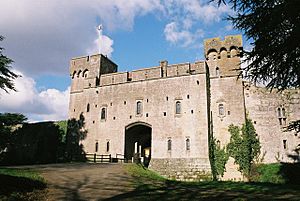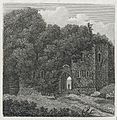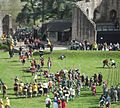Caldicot Castle facts for kids
| Castell Cil-y-coed | |

The front entrance through the gatehouse
|
|
| Lua error in Module:Location_map at line 420: attempt to index field 'wikibase' (a nil value). | |
| Established | 1100 |
|---|---|
| Location | Caldicot, Monmouthshire, Wales |
| Type | Historic house museum |
Caldicot Castle (which is Castell Cil-y-coed in Welsh) is a large stone medieval castle. It's found in the town of Caldicot, Monmouthshire, in southeast Wales. The castle was built around the year 1100. It stands near where Harold Godwinson once had a Saxon castle. Norman earls from Hereford started building it. Caldicot Castle was officially recognized as a Grade I listed building on June 10, 1953. This means it's a very important historical site.
Contents
Early History of Caldicot Castle
Caldicot is mentioned in the Domesday Book from 1086. This old book didn't talk about a castle, but about a farm owned by Durand of Gloucester. His nephew, Walter FitzRoger, later inherited the land. Walter's son, Milo, became the Earl of Hereford. Around the time of Henry I of England, the castle was likely a simple motte-and-bailey design. This means it had a wooden tower on a small hill, surrounded by a fence.
The Bohun Family and Castle Building
Milo had five sons, but none of them had children. So, his oldest daughter, Margaret, inherited the Earldom of Hereford and Caldicot. She married Humphrey II de Bohun. Their son, Humphrey III de Bohun, probably built the stone keep (main tower) and outer walls. This happened around 1170. The Bohun family owned Caldicot Castle for over 200 years.
Thomas of Woodstock's Time
In 1376, Caldicot Castle became the property of Thomas of Woodstock. He was the fifth son of King Edward III of England. Thomas gained the castle when he married Alianore de Bohun.
Thomas and King Richard II
When King Edward III died, his grandson, Richard II, became king at just nine years old. As the new king's uncle, Thomas helped advise him. He was also made the Lord High Constable of England. Thomas didn't visit Caldicot often. His main home was in Pleshey, Essex, which was closer to the king's court.
Castle Improvements and Trouble
In 1381, there was a big uprising in Essex called the Peasants' Revolt. This might be why Thomas decided to stay at Caldicot that year. While he was there, he ordered major new work on the castle. A new gatehouse and a drawbridge were built. A new tower with private rooms was also added at the back of the castle. This tower is now called the Woodstock Tower. Two carved stones were placed at the bottom of this tower. One was marked 'Thomas' and the other 'Alianore'.
Over time, Thomas and King Richard's relationship became difficult. In 1397, King Richard ordered Thomas to be kidnapped and killed. After his death, Thomas's property, including Caldicot Castle, was taken by the Crown.
The Castle and the House of Lancaster
In 1399, Henry Bolingbroke took the throne from King Richard. He became King Henry IV. Henry's wife, Mary de Bohun, had died before he became king. Their son, Henry V, was born at Monmouth Castle. He later became a famous hero, winning the Battle of Agincourt.
After Alianore and Mary de Bohun's mother, Joan, died, the Bohun family's estates were reorganized. Alianore's oldest daughter, Anne, lost Caldicot to King Henry V. Because of this, Caldicot Castle became part of the large Duchy of Lancaster. Henry's widow, Katherine of Valois, held the castle for a while. Later, the Herbert family managed it for much of the 1400s. In the 1500s, it was leased to the Somersets, who were powerful in Raglan.
Decline and Restoration of Caldicot Castle
Caldicot Castle was eventually left uncared for. It fell into ruin and became mostly a farmyard. In 1857, Charles Lewis bought the castle. He sold it to Joseph Richard Cobb in 1885. Joseph Cobb then started to restore the castle to make it his family home.
The Cobb Family's Efforts
The Cobb family owned the castle from 1885 to 1964. Joseph Cobb's family stayed at the castle after he died. His son, Geoffry Wheatly Cobb, and especially his daughter-in-law, Anna, continued the restoration work. In the early 1900s, many rooms were decorated with items from Nelson's first flagship, HMS Foudroyant. Geoffry Wheatly Cobb had owned this ship at the end of its life.
G. W. Cobb passed away in 1931. After Anna died in 1943, the castle went to Joseph's grandson, Geoffry Richard Wheatly Cobb. He created furnished apartments in three of the towers and parts of the gatehouse for people to rent.
Public Ownership and Use
In 1964, the Chepstow Rural District Council bought the castle from the Cobb family for £12,000. At that time, more council housing was available, so the castle apartments were no longer needed. The castle, which included a small museum, opened to the public in 1965. After 1967, medieval-style banquets were held there, making it a fun place for visitors.
Gallery
-
A re-enactment of a Civil War skirmish inside the castle








